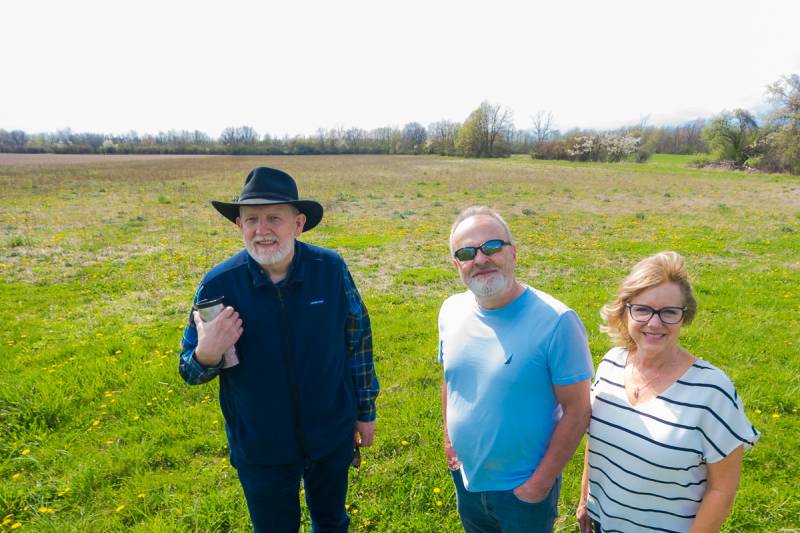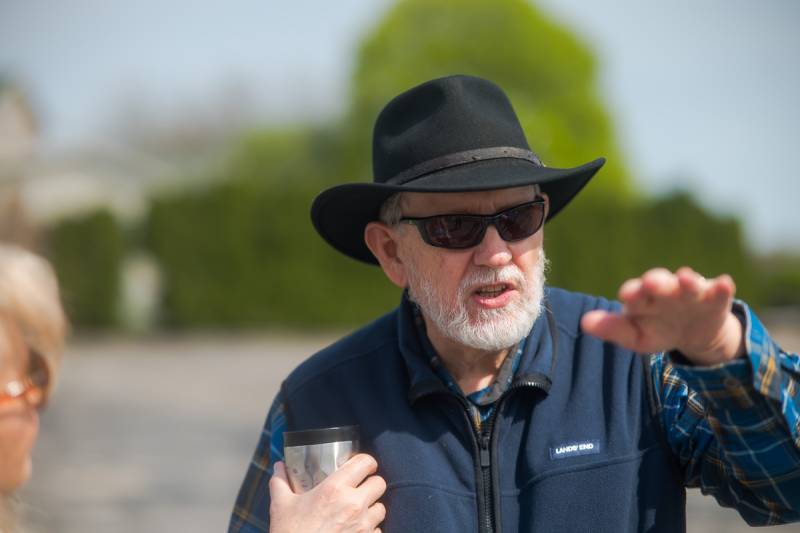
Photo by Howard Owens
Serving as a perfect metaphor for what’s happening at Cornerstone Church, seeds of an idea have been planted and are being nurtured by members and leaders for a future organic, self-sustaining farm on several acres adjacent to the Bank Street Road site, Pastor Paul Doyle says.
Growing right out of the book of Genesis, where it says, “Let the land produce vegetation: seed-bearing plants and trees on the land that bear fruit with seed in it,” Doyle said, he believes that this project is a type of divine intervention that has drawn people and their farm-related talents to participate in an effort that will help feed those in need.

“He thought of everything. He put the nutrients in, and certainly, the movie that we saw, that inspired us, contrasted with what we see happening to food. And I don’t know what they’re putting in it, I don’t know how it’s been manipulated. It’s scary to me, and we don’t always know what we’re putting in our bodies. God already thought of all this, and so we just kind of connected the dots and said, you know what? We’ve got the land, we’ve always wondered we’re like this church out in the cornfield, and we’re surrounded by land, and then the land became available and we just began to get into prayers and we really felt strongly.”
What served as inspiration
That movie was “The Biggest Little Farm,” a documentary film that follows an eight-year journey of John and Molly Chester as they depart urban life in Los Angeles and embark on a farming quest to create a sustainable, biodiverse 234-acre farm named Apricot Lane Farms.
Their efforts to work with nature encounter drought, pests, predators, and soil depletion as they tirelessly learn how to establish a balanced system of vegetation and animals.
Divine intervention, human efforts
Alan Goodfellow, a church elder, stepped forward to lead Cornerstone’s project, not because of his most recent experience from Kodak and as a financial advisor as much as from growing up on a farm in central Pennsylvania and an agricultural heritage stemming from Montana.
“Because of his background, his heart, when he retired, was to do some farming. He’s already done a lot of research, and when we announced it, all of a sudden, people came out of the woodwork in our church and go, I have background in compost, I have background, and so it just felt like things were coming together,” Doyle said. “So some of it’s logical, and some of it feels like it’s divine intervention. But the Bible says that the earth is the Lord’s and the fullness thereof. He did it for years without man’s manipulation.”
They plan to work the ground, just not fill it with chemicals and pesticides and deplete it of natural nutrients, he and Goodfellow said. The church plans to use 18 acres that it owns, with a potential opportunity to purchase more property in the near future.
"We don't believe it's happenstance. We believe it was in the mind of God to bring this into being, where everything works together. It's an experiment where we want to try it, and we don't grow it. God grows it. We just made a decision and we have a conviction, I think, because we saw somebody else kind of be the forerunners,” Doyle said, referring to the Chester couple. “They showed it can happen. Why not? Why not here in Batavia, with rich soil? We have plenty of precipitation. You know, we have a beautiful winter that fertilizes the ground, and there's certainly a need.”
Goodfellow seems to know his stuff, rattling off a system of fixing nitrogen in the ground and grouping crops, such as corn, beans and squash so that the beans have something tall to grow against — the corn stalks — and squash leaves provide natural ground cover to discourage weeds and protect the soil.
He keenly understands that plowing the earth year after year only takes away from Mother Nature, which is why chemical fertilizers have to be used to boost the soil back up for the next go round of planting. But by not disturbing the soil as much with aggressive tilling, and using a drill to plant seeds for crops, which uses the elements already provided by nature, he said.
“They’re throwing up dust, right?” he said, nodding to a tractor plowing out in a field along Bank Street Road. “So one of the primary principles that we’re going to have is that we’re not going to till the ground. There’s going to be cover on the ground at all times. So there is such a thing as no-till planting, where you have what they'll call a drill.
“It's not really a drill in the sense you think of … it opens the ground enough to create a trench, and then you drop the seeds in the trench,” he said. “But you do that even with the covering on top of the ground.”
And what's the advantage of that?
“You're not losing soil, and the soil is really a living mechanism, so all the root structure, enzymes, bacteria, earthworms, and other kinds of bugs live under the soil. And when you're doing this, what we call monoculture, single crop, you have to spray to control weeds,” Goodfellow said. “You have to put chemical fertilizers into replenish what's been taken out of the soil before. And instead, what we're going to do is replenish by using cover crops constantly.”
There will be a cover crop, such as low-lying cold grasses, flowers or squash, planted on top of those.
“So you’re always building up your soil to keep the organic material down in the soil,” he said. “So if you have dry spells, having all that organic matter below that moisture is going to feed the growth. And there’s all kinds of things that take place, where the root system that develops underneath the ground, amongst all those different types of cover crops, is going to help bring the nitrogen, phosphorus, potassium levels in the soil up so you don’t require chemical fertilizers. That’s why they have to use fertilizer, because there’s nothing regenerating the soil.
“That’s our whole plan to regenerate the soil, put more back into the soil, and the cycle then will come down to adding animals to it as well,” he said. “Because the animals will forage on the cover crop, then leave the manure on the field, and that will be dissipated through other techniques that will spread, get down into the soil system, and move all around so it’s shared into large sections.”
Completing the plan
They’re thinking of adding chickens, cows and pigs to the system as the primary three additions. Following a farmer from North Dakota who has hardy stock that can weather most climates, Goodfellow believes these animals can thrive outdoors without a barn if they are the appropriate breeds for the Western New York climate.
Everything seems to fall in line with this system, as the cows and pigs eat the cover crops and deposit manure, the chickens scratch at the manure for the larvae left by flies, and the manure breaks down into fertilizer for the soil, Goodfellow said.
Harvested crops may be sold to those who can afford them, or distributed through the church’s food pantry. Remainders that can be kept, such as winter squash, beets, onions, or potatoes, will be stored in an adjacent 50-by-50 warehouse on the premises along with FoodLink supplies and massive toy collections for Christmas giveaways.
They recognize the need for “lots of equipment” for this objective, so another 30-by-50 maintenance room will be handy for upkeep and repairs.
Goodfellow has organized teams of about 30 volunteers so far, intending to have a garden by the end of this summer. He said hives of bees should also contribute to the pollination effort. For everything he learned from his elders, he now must take a different path.
“My grandfather, my mother, myself, we were all raised on the monoculture, industrial type farming, even if it was a truck farmer, he planted in rows, he planted on bare ground. He tilled the ground with plows and discs, etc.,” he said. “And so I'm in the process of unlearning everything I knew about agriculture and relearning new ways, new techniques, new reasons why. That's really where we are right now at the present time. And now we’re going to try out some of the stuff we’ve learned.”
He said people who farm this way end up with higher yields for their crops than the average in their area versus the traditional crop. The more he learns, the more “it makes so much sense” and is consistent with “God's thinking.”
“That you would be replenishing, regenerating all the time, instead of just getting rid of the weeds,” he said.
Follow The Batavian for periodic updates on this project.
The food pantry is open 11 a.m. to 1 p.m. Tuesdays, 1 to 3 p.m. Fridays and 12:30 to 1:30 p.m. Sundays at the church, 8020 Bank Street Road.

